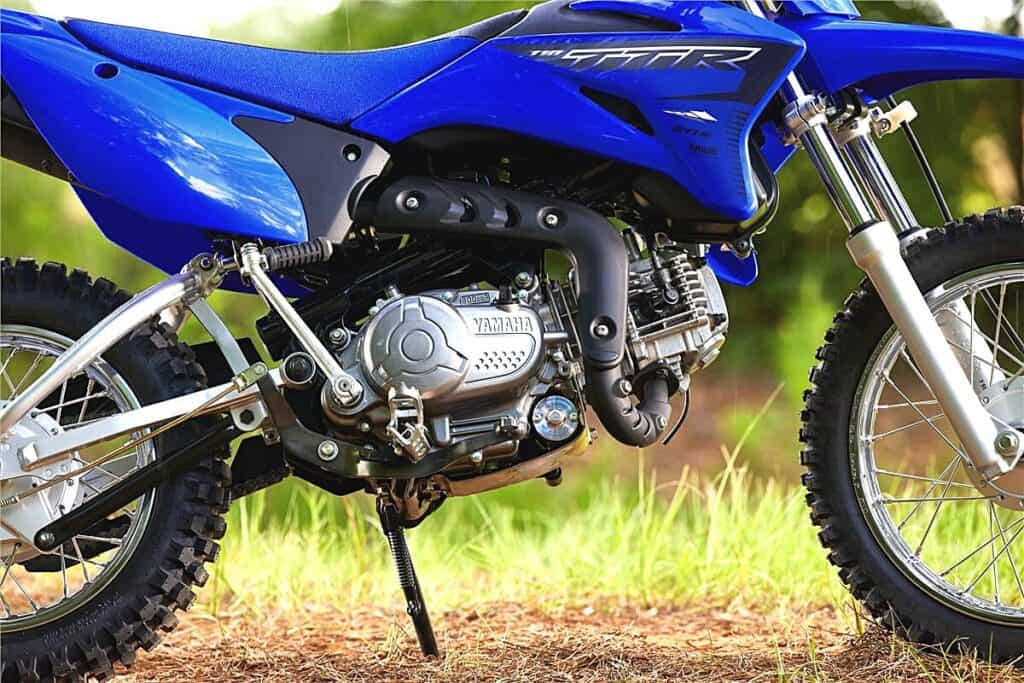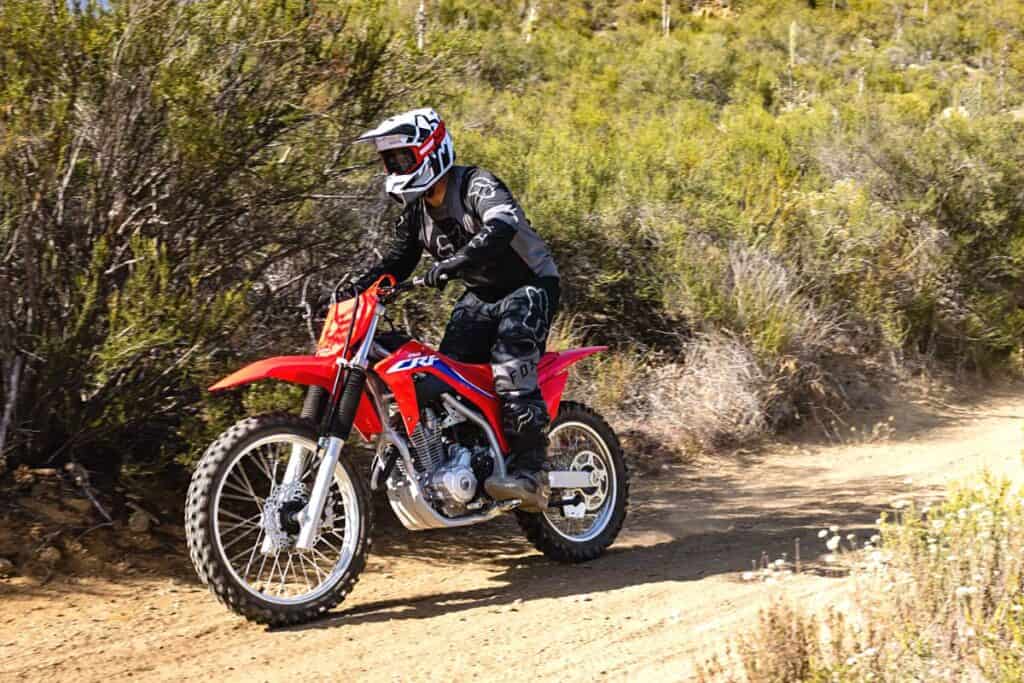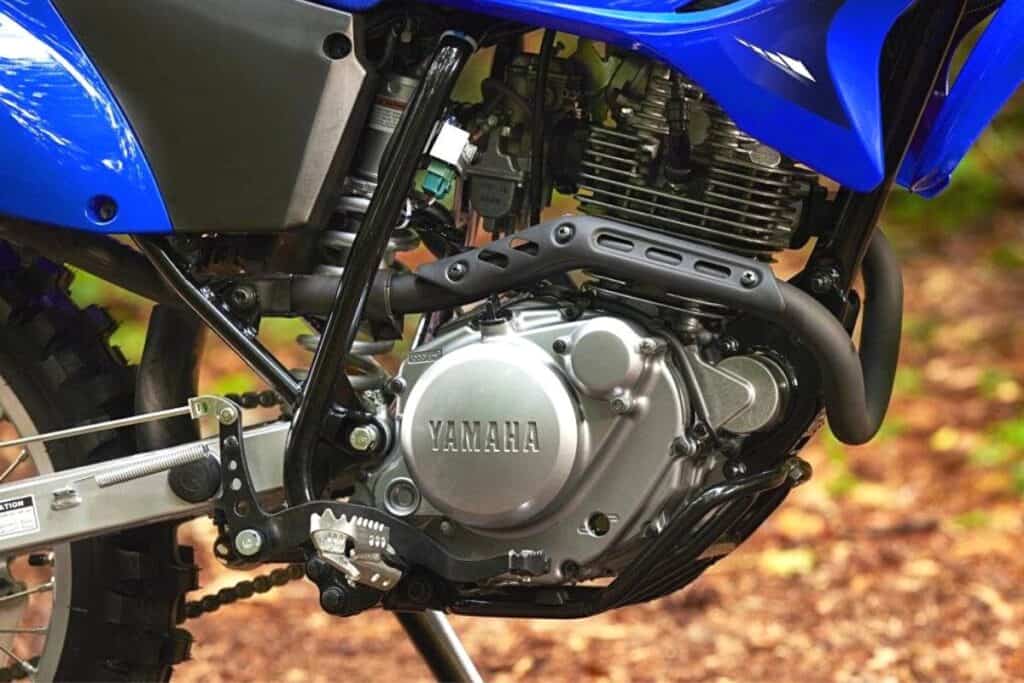Whether you’re a new dirt bike rider or a seasoned pro, at some point, you’ve probably wondered if your dirt bike has an air-cooled or liquid-cooled engine.
Understanding your bike’s cooling system is important for both performance and proper maintenance.
When riding over rough terrain and pulling off daring jumps, dirt bikes generate a tremendous amount of heat.
Without an effective cooling system, all that heat could cause serious damage to the sensitive engine components.
Many dirt bikes, especially trail and recreation bikes at or under 250cc, utilize air-cooled engines. This means they rely solely on the flow of air, rather than liquid coolants running through a radiator, to control temperature.
However, high-performance trail and motocross bikes, especially those over 250cc will often use liquid cooling to handle the higher power output.
So why do some motorcycles use air and others need water-based liquid to stay cool?
In this blog post, we’ll cover everything you need to know about air-cooled dirt bikes including their advantages as well as their disadvantages.
Let’s get into the details!
What is an Air Cooled Engine?

An air-cooled engine refers to any engine that relies on air flowing over its hot components to cool it, rather than a liquid coolant pumped through a radiator.
Without a radiator, hoses, water pump, and other cooling system parts, air-cooled motors are a simpler, more basic design.
In an air-cooled dirt bike engine, fins are added to key high-heat areas like the cylinder head and cylinder barrel. As air flows over these fins while riding, heat transfers from the engine into the air and dissipates rather than building up internally.
The faster you ride, the more cooling airflow your engine receives.
Air-cooled engines have been around since the beginning of motorcycles. They dominated the industry for decades due to their lightweight, uncomplicated nature and decent cooling for lower-performance bikes.
However, as horsepower levels climbed, many manufacturers added water cooling to better manage heat.
While liquid cooling offers unrivaled temperature control, air cooling remains popular for its simplicity and cost savings.
It gets the job done for many dirt bikes, especially trail and leisure bikes.
Are Most Dirt Bikes Air Cooled?

Many dirt bikes with engine displacements at or below 250cc utilize air-cooled engines, including most trail and recreational bikes.
However, more high-performance trail and motocross bikes, especially those above 250cc typically use liquid cooling, due to the system’s superior cooling capability.
But why is this?
There are a few main reasons why air-cooled motors continue to persist in dirt bike design:
- Simplicity – Removing the entire liquid cooling system eliminates many failure points and maintenance needs for the average rider. Air-cooled bikes are easier to own and work on.
- Weight Savings – Coolant, radiators, hoses, and water pumps add unwanted pounds. Air-cooled bikes are lighter, which provides better handling, especially for smaller riders.
- Cost – Liquid systems add considerable cost to a dirt bike both when purchasing and when it’s time for maintenance. Air cooling makes bikes more affordable.
- Heat Management – Air cooling adequately controls heat for the output levels of most basic and amateur dirt bikes. It doesn’t hinder performance until hitting higher horsepower.
Popular Dirt Bikes that Use Air Cooling
- Honda CRF125F
- Honda CRF250F
- Yamaha TT-R110E
- Yamaha TT-R230
- Kawasaki KLX110R
- Kawasaki KLX140
- Suzuki DR-Z125L
- GPX FSE250E
- SSR SR110DX
- MotoTec X3
Benefits of Air-Cooled Dirt Bike Engines

While liquid cooling offers maximum thermal control, air-cooled dirt bike engines provide several advantages that have sustained their popularity over the decades, which we’ve listed below.
Lightweight Construction
By eliminating the liquid cooling system, air-cooled motors shed several pounds off the total weight of the motorcycle.
Though the engine itself will have additional metal, surface area, and fins to help with cooling, the net savings are still in favor of air-cooled dirt bikes, when it comes to weight.
For example, the radiator alone on a liquid-cooled bike adds 4 to 6 pounds in many cases. Then factor in the weight of hoses, fittings, water pump, coolant reservoir, and 1 to 2 gallons of coolant, and you’re talking 10 to 15 pounds of extra weight.
Removing the entire setup helps offset any extra engine material needed for cooling.
The result is typically a 5 to 8-pound overall weight reduction on air-cooled dirt bikes versus comparable displacement liquid-cooled bikes.
Simplified Design
By removing the entire liquid cooling system, air-cooled engines eliminate many potential failure points and maintenance requirements associated with complex cooling systems.
There’s less to leak, less to break, and less to replace.
On liquid-cooled bikes, you need to monitor coolant levels, change out old coolant, inspect rubber hoses for cracks or tears, confirm the radiator isn’t bent or plugged, verify water pump condition, watch for stuck thermostats, replace corroded fittings, and keep gaskets sealed.
That’s a lengthy to-do list!
On the other hand, an air-cooled motor essentially just needs adequate airflow and proper oil viscosity.
This simplified design translates into fewer breakdowns and headaches for riders.
Plus, removing complexity adds durability and cuts down expenses should repairs ever be needed.
Enhanced Air Circulation
Air-cooled engines are designed to maximize surface area, greatly aiding in heat dissipation compared to liquid-cooled motors recirculating hot internal coolant.
More air contact equals better cooling potential.
Fins protruding from the cylinder and head draw heat out into the passing air stream as riding speed increases.
Air-cooled bikes take advantage of airflow for cooling, unlike liquid systems relying solely on water pumps and heat exchangers.
Reduced Maintenance
Without liquid coolant and the entire cooling system infrastructure of hoses, pumps, and radiators, air-cooled engines have dramatically fewer points of failure and fluid maintenance requirements.
Liquid-cooled bikes must periodically flush and refill corroded coolant to avoid overheating damage, whereas air-cooled ones need no such servicing.
Nor do they have leaks from cracked hoses, weeping around gaskets or seals, or pumps/thermostats seizing up, which can leave riders stranded trailside and facing hefty repairs.
Even the coolant itself can rot hoses or cause corrosion inside the engine over the years. Due to improper coolant pH, poor mix ratios, or using straight water.
Drawbacks of Air Cooling in Dirt Bikes
Although air cooling has its pros, relying solely on airflow does have some cons, especially in extreme riding conditions, as we’ve highlighted below.
More Heat Exposure
With no liquid coolant acting as a heat sink, the engine components themselves directly absorb more heat.
The cylinder, cylinder head, valves, and piston are subjected to hotter and more concentrated heat contact.
Over time, increased thermal exposure can accelerate material expansion, distortion, oxidation, cracking, or other heat-related damage, especially in high-stress areas like valve seats and piston rings.
This in turn, over time, can negatively affect performance, emissions, and longevity.
Higher Operating Temps
Without liquid coolant regulating temperatures, air-cooled motors run hotter in general.
While normal airflow cooling is adequate for mild riding, leaning hard on the twist throttle for extended periods causes heat to build up rapidly.
Pushing an air-cooled engine for an extended period at sustained high rpms, common in motocross riding, causes extreme heat soak throughout the engine.
Which can cause temporary performance loss or even engine damage in the worst-case scenario.
Increased Overheating Risk
Pushing an air-cooled engine too hard for too long can overwhelm its ability to shed heat, leading to dangerous overheating conditions.
Without coolant to absorb and dissipate thermal energy, heat rapidly builds up.
Once overheated, heads can warp and oxidization can occur, drastically reducing engine life. Piston rings can also lose critical tension against the cylinder, causing blow-by, compression loss, and oil burning.
In addition, high heat will also break down the oil inside the engine much faster, greatly reducing its effectiveness and its lubricating properties.
Performance Limitations
Air cooling effectiveness starts dropping off above 50 to 60 horsepower, which constrains peak power production.
Dirt bikes and dual sport models offering liquid cooling, in general, provide higher horsepower, thanks to their thermal advantages.
Reduced Power Capability
Air-cooled motors offer lower power output than liquid-cooled engines of equal cylinder volume.
Their larger surface area and heavier construction, which are needed to shed heat, result in poorer power-to-weight ratios.
The extra metal and surface area required for sufficient air cooling adds pounds.
This increased heft hurts acceleration, suspension control, and handling compared to more compact, potent liquid-cooled powerplants.
Got More Questions? We’ve Got More Answers…
Recent Posts
Is Can-Am Better Than Polaris? This question has been debated for years, sparking intense debates in off-road communities and showrooms. As two titans in the world of ATVs and UTVs, Can-Am and...
Whether you're an adult looking for a new adventure or introducing your kids to the sport, finding the best beginner dirt bike is crucial to kick-start your off-road journey on the right...

